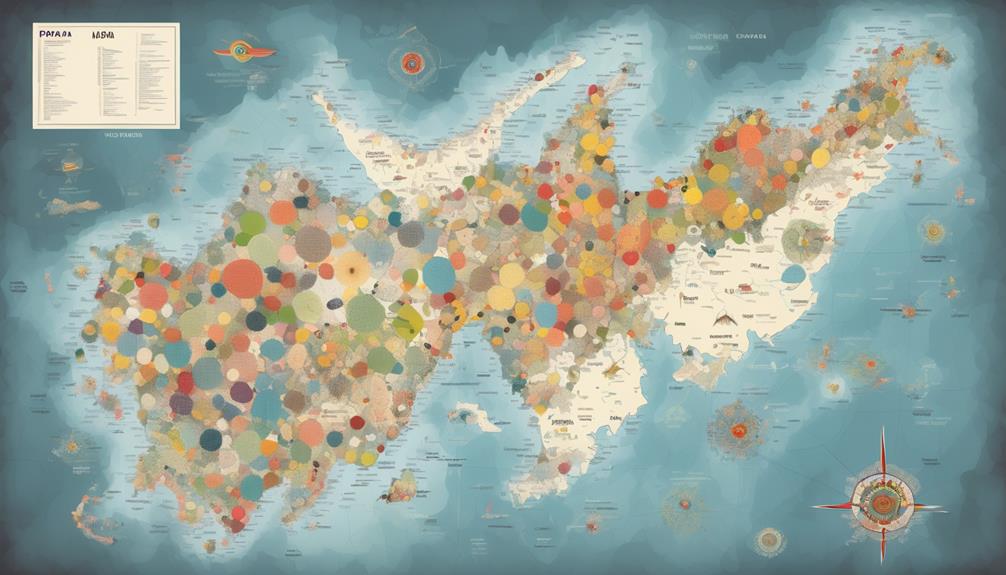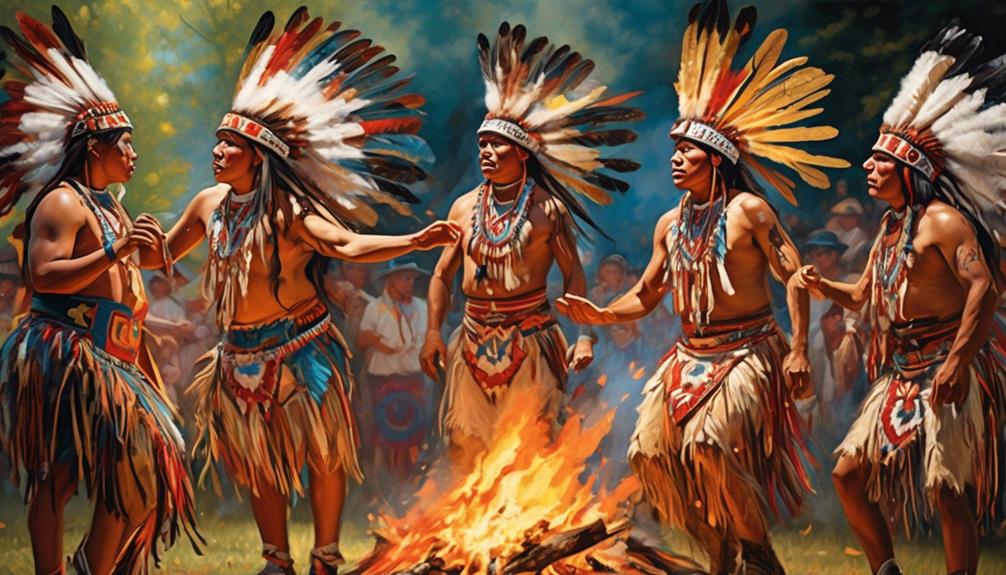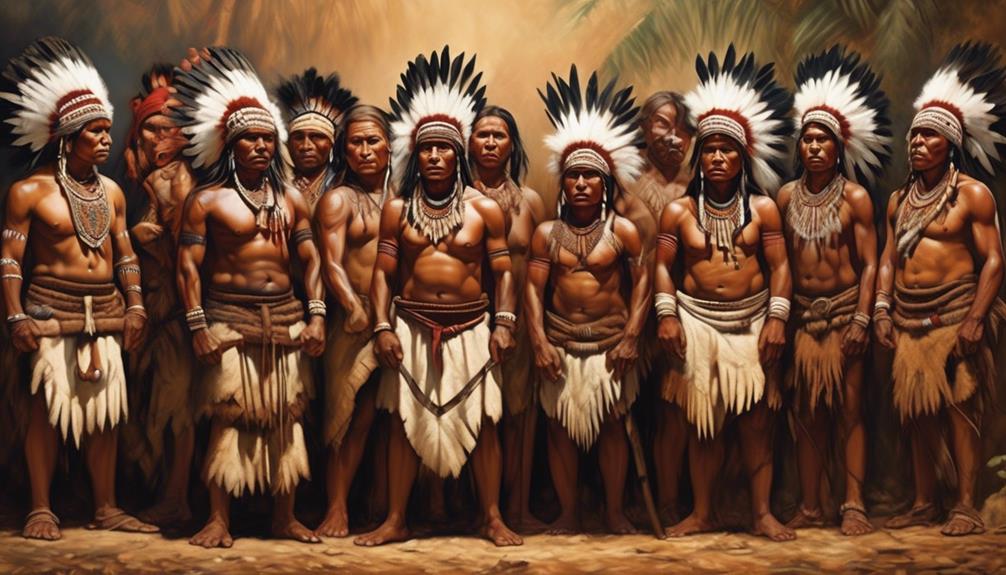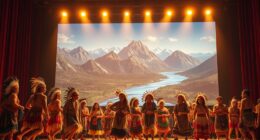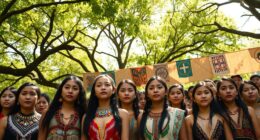Celebrating Indigenous Peoples Day honors the vibrant histories and resilient cultures of indigenous communities worldwide. It started as a way to recognize their contributions and promote awareness of ongoing challenges they face. Across the globe, celebrations include traditional dances, storytelling, art festivals, and language revitalization efforts. These traditions showcase the enduring spirit and diversity of indigenous peoples. If you continue exploring, you’ll discover how these cultural expressions foster respect, recognition, and ongoing efforts to preserve and empower indigenous communities everywhere.
Key Takeaways
- Indigenous Peoples Day, celebrated on October 9th, honors Indigenous histories, cultures, and contributions worldwide.
- The day promotes cultural preservation, including language revitalization and traditional practices.
- Global traditions include powwows, storytelling festivals, dance performances, and art exhibits.
- Celebrations highlight Indigenous resilience, rights, and ongoing efforts to maintain cultural identities.
- The day encourages learning, solidarity, and recognition of Indigenous communities’ enduring legacies.

Have you ever wondered why October 9th is celebrated as Indigenous Peoples Day? It’s a day dedicated to honoring the rich histories, cultures, and contributions of Indigenous peoples across the globe. This day offers an opportunity to recognize their resilience and to promote awareness about their ongoing struggles. One key aspect of this celebration is cultural preservation, which involves safeguarding traditions, practices, and stories that have been passed down through generations. Central to this effort is the preservation of indigenous languages, many of which are endangered or at risk of extinction. By revitalizing these languages, communities aim to maintain their unique identities and pass their cultural heritage to future generations. Learning and using indigenous languages is a powerful act of resistance, reaffirming their significance and fostering a sense of pride within communities. It also helps to combat the historical suppression many indigenous groups faced, where their languages and traditions were intentionally marginalized or erased. On Indigenous Peoples Day, various initiatives focus on language revitalization programs, community storytelling, and cultural workshops, all intended to strengthen connections to ancestral roots. These efforts are vital because language embodies a community’s worldview, values, and history. When indigenous languages thrive, so does their culture and collective identity. Globally, celebrations vary—from powwows and traditional dances to storytelling festivals and art exhibits—each emphasizing cultural resilience. In many places, indigenous groups use this day to educate others about their history and current issues, advocating for rights and recognition. It’s also a time for non-indigenous allies to stand in solidarity, learning about the importance of respecting indigenous sovereignty and supporting cultural initiatives. The act of cultural preservation isn’t just about keeping old traditions alive; it’s about empowering communities to define their futures on their terms. Indigenous Peoples Day reminds us that these cultures are living, evolving entities that deserve respect and recognition. By focusing on language revitalization efforts, communities reaffirm their identities and ensure that their stories continue to be told. Whether through language classes, cultural festivals, or community-led projects, the goal is to create a sustainable future where indigenous cultures flourish. Recognizing the importance of cultural resilience can inspire broader support for indigenous rights and initiatives. Celebrating this day means recognizing the strength and resilience of indigenous peoples worldwide. It’s about honoring their contributions, supporting their rights, and guaranteeing that their cultural legacy remains vibrant. Ultimately, Indigenous Peoples Day is a call to action for everyone to learn, listen, and stand in solidarity with indigenous communities, helping to preserve their languages and cultures for generations to come.
Frequently Asked Questions
How Do Different Countries Observe Indigenous Peoples Day Globally?
You’ll find countries observe Indigenous Peoples Day through cultural preservation activities like festivals, traditional dances, and art displays, honoring indigenous heritage. Some nations seek international recognition by hosting official events or issuing statements supporting indigenous rights. These celebrations promote awareness, foster respect, and strengthen indigenous communities worldwide. By participating, you help celebrate diverse traditions and contribute to global efforts to preserve and honor indigenous cultures for future generations.
What Are Traditional Indigenous Celebrations on This Day?
On this day, you can experience traditional indigenous celebrations through vibrant Indigenous dance performances and displays of traditional crafts. These events often include storytelling, singing, and rituals that honor their heritage. Participating in or observing these activities helps you connect with indigenous cultures, showing respect and appreciation for their rich customs. These celebrations serve as a powerful reminder of their history and resilience, fostering greater understanding and unity.
How Has Indigenous Peoples Day Impacted Indigenous Rights Worldwide?
You might think one day can change everything, but Indigenous Peoples Day sparks real progress through activism and cultural preservation. It shines a spotlight on indigenous rights worldwide, inspiring communities to push for justice and recognition. While it’s not a magic fix, this day fuels momentum, empowering indigenous peoples to claim their stories and protect their traditions—proving that even a single day can be a catalyst for global change.
Are There Any Controversies Surrounding the Holiday’s Recognition?
You might notice that some controversies surround Indigenous Peoples Day, mainly due to cultural appropriation and political debates. Critics argue that celebrating the day can lead to trivializing indigenous cultures or misusing their symbols. Additionally, political debates focus on whether the holiday should replace Columbus Day or highlight indigenous rights. While many see it as a positive step, these controversies show that respect and understanding are essential in recognizing indigenous communities.
How Can Individuals Support Indigenous Communities on This Day?
You can support indigenous communities on this day by actively engaging in their cultural preservation efforts. Attend local events, learn about their traditions, and listen to their voices. Show respect by supporting indigenous businesses and organizations. Your community engagement helps amplify their stories and struggles, fostering understanding and solidarity. Small actions like these make a meaningful difference in honoring their heritage and promoting ongoing cultural preservation.
Conclusion
As you celebrate Indigenous Peoples Day, remember it’s a vibrant tapestry woven with history, culture, and resilience. Like a rising sun, their traditions illuminate our shared world, reminding us to honor their stories and spirits. Embrace this day as a rhythmic dance of respect and unity, letting their voices echo through time. Together, we keep the flame alive, ensuring their legacy shines brightly for generations to come.
Mary is a passionate writer who brings creativity and a fresh perspective to our team. Her words have the power to captivate and inspire, making her an essential contributor to our content. Mary’s commitment to storytelling and dedication to promoting Indigenous culture ensures that her work touches the hearts of our readers. We’re fortunate to have her as part of our team.


